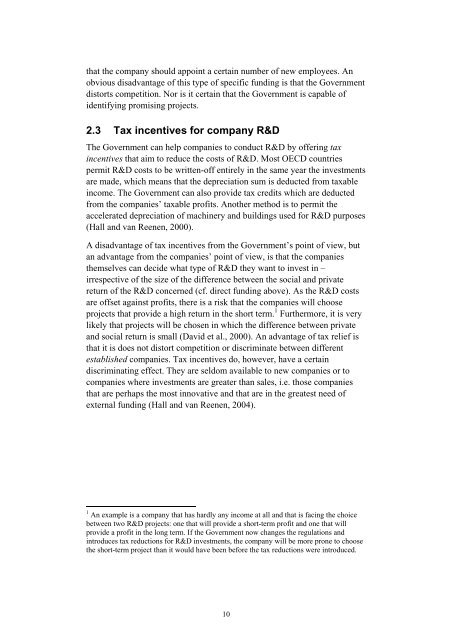Growth through Research and Development - what does ... - Vinnova
Growth through Research and Development - what does ... - Vinnova
Growth through Research and Development - what does ... - Vinnova
Create successful ePaper yourself
Turn your PDF publications into a flip-book with our unique Google optimized e-Paper software.
that the company should appoint a certain number of new employees. Anobvious disadvantage of this type of specific funding is that the Governmentdistorts competition. Nor is it certain that the Government is capable ofidentifying promising projects.2.3 Tax incentives for company R&DThe Government can help companies to conduct R&D by offering taxincentives that aim to reduce the costs of R&D. Most OECD countriespermit R&D costs to be written-off entirely in the same year the investmentsare made, which means that the depreciation sum is deducted from taxableincome. The Government can also provide tax credits which are deductedfrom the companies’ taxable profits. Another method is to permit theaccelerated depreciation of machinery <strong>and</strong> buildings used for R&D purposes(Hall <strong>and</strong> van Reenen, 2000).A disadvantage of tax incentives from the Government’s point of view, butan advantage from the companies’ point of view, is that the companiesthemselves can decide <strong>what</strong> type of R&D they want to invest in –irrespective of the size of the difference between the social <strong>and</strong> privatereturn of the R&D concerned (cf. direct funding above). As the R&D costsare offset against profits, there is a risk that the companies will chooseprojects that provide a high return in the short term. 1 Furthermore, it is verylikely that projects will be chosen in which the difference between private<strong>and</strong> social return is small (David et al., 2000). An advantage of tax relief isthat it is <strong>does</strong> not distort competition or discriminate between differentestablished companies. Tax incentives do, however, have a certaindiscriminating effect. They are seldom available to new companies or tocompanies where investments are greater than sales, i.e. those companiesthat are perhaps the most innovative <strong>and</strong> that are in the greatest need ofexternal funding (Hall <strong>and</strong> van Reenen, 2004).1 An example is a company that has hardly any income at all <strong>and</strong> that is facing the choicebetween two R&D projects: one that will provide a short-term profit <strong>and</strong> one that willprovide a profit in the long term. If the Government now changes the regulations <strong>and</strong>introduces tax reductions for R&D investments, the company will be more prone to choosethe short-term project than it would have been before the tax reductions were introduced.10
















